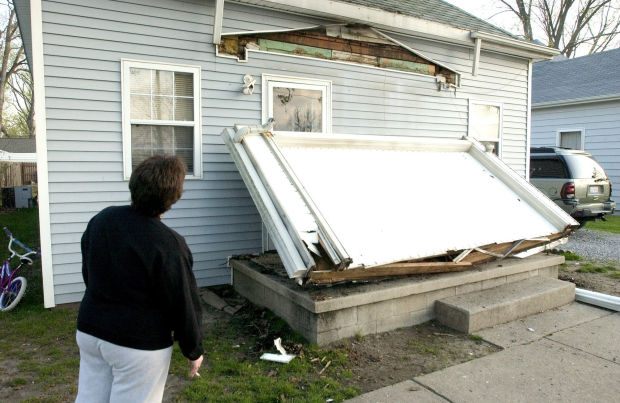Central Illinois rattled by occasional earthquake since pioneer era
"No damage was done in this city or elsewhere, as the shock did not reach sufficient severity to damage buildings, but many people were alarmed and others pretty thoroughly frightened," noted The Pantagraph after a Sept. 26, 1891, earthquake rippled through the area. "It is not often Bloomington is visited by such awe-inspiring phenomenon and her citizens do not feel familiar with them at all."
Central Illinois has been — and will continue to be — rattled by an occasional quake from two areas of seismic activity, the well known New Madrid zone along the Missouri-Tennessee border and the Wabash Valley zone that includes much of southeastern Illinois.
One of the first reported earthquakes in what becomes Illinois occurred in 1795 and was felt in Kaskaskia, the old French settlement and future state capital located south of St. Louis.
The New Madrid earthquakes of Dec. 16, 1811 (there were two, spaced about five hours apart) were incredibly powerful, with estimates of magnitudes generally ranging from the mid-7s to the low 8s. Losses of life, limb and property were minor because the region was sparsely settled at the time, though today similar quakes would likely kill thousands and reduce hundreds (if not thousands) of buildings to rubble.
The first Euro-Americans didn't begin settling present-day McLean County until the early 1820s, so while there are no local accounts of the New Madrid earthquakes (and there were two more mighty shocks the following year), rest assured they "rocked the world" of the Kickapoo, Potawatomi and Delaware living here.
Some 45 years later the Native Americans had been forcibly removed and the McLean County seat of Bloomington was a booming railroad town. On Oct. 8, 1857, local residents were shaken by a severe earthquake centered somewhere between St. Louis and Centralia. "The earth was quite unsteady in this place night before last — two shocks taking place between twelve o'clock and daylight," reported The Pantagraph.
The Sept. 26, 1891 quake mentioned above visited Bloomington at 11:02 p.m. "Those who were awake at that time were suddenly conscious of a queer sensation the like of which very few had ever before experienced," noted The Pantagraph. "Some thought their houses were being entered by burglars, and a few women were so positive of that conviction that they screamed to awake their neighbors."
Another earthquake rolled through this stretch of Central Illinois on Oct. 31, 1895, with area residents awakened about 5:15 a.m. to "a great swaying of their beds, and the rattling of their windows, and the promiscuous dancing of furniture." It was, added The Pantagraph, "old mother earth having an ague fit" ("ague" meaning malaria or similar illness involving feverish shivering).
The "boys" of Bloomington Fire Department's No. 1 engine house, 104 N. East St., did some lively stepping when the quake hit. "They skinned down the poles and out into the street, fastening their clothes as they went and inwardly wishing they had paid more heed to the words of revivalist (John Wilbur) Chapman during his last visit to the city," teased The Pantagraph.
Earthquakes continued to visit Central Illinois throughout the 20th century and into the present one. The morning "temblor" of May 26, 1909, could be felt in parts of Iowa, Michigan, Wisconsin and Illinois. Damage in Bloomington included a toppled chimney at 510 W. Washington St.
Wild rumors spread among locals that the quake had left 10,000 dead in St. Louis and Chicago's business district in ruins, none of which were true. And the Associated Press erroneously reported out of Bloomington that the quake "so badly damaged the county jail building that it will have to be rebuilt." The actual damage proved to be little more than some cracks in a rear wall that required "a few buckets of plaster."
More recently, a June 10, 1987, earthquake shook this area, including the nuclear power plant in nearby Clinton, and many will remember waking up nearly seven years ago, at 4:30 a.m. April 18, 2008, to a 5.2-magnitude quake.
Although such quakes can seem little more than a curiosity, the New Madrid zone looms ominously over the Mississippi Valley. Seismologists predict that in the next 50 years there's something like a 10 percent chance of a similar magnitude earthquake to those of 1811-1812, and a 25 to 40 percent chance of a magnitude 6 or greater over that same time.
A major New Madrid earthquake would wreak havoc over parts of Alabama, Arkansas, Illinois, Indiana, Kentucky, Mississippi, Missouri and Tennessee. There would be impassable roadways, collapsed bridges, breached levees and an unnavigable Mississippi River. According to one estimate a magnitude 7 earthquake would destroy more than half the buildings in St. Louis and Memphis, Tenn.
The 1998 big-budget action movie "Armageddon," a highly improbable account of NASA diverting an asteroid on a collision course with Earth, opens with narrator Charleston Heston recounting the dinosaur-killing one that hit our planet some 66 million years ago. Intones Heston: "It happened before. It will happen again. It's just a question of when."
The same frightful thing can be said about the next New Madrid "big one."
--
__._,_.___


No comments:
Post a Comment